Karting, a captivating motorsport, has garnered a multitude of fans and racers, turning it into a thrilling spectacle on the racing circuits.
Despite the seemingly simple appearance of these small mechanical racing cars, they embody a wealth of technology and engage in fierce competition, creating a captivating ambiance on the tracks.
Origins and Evolution
Go-karts trace their roots back to the United States in the 1950s. Initially conceived as an informal pastime, karting emerged as an entertainment activity where enthusiasts drove homemade racing cars in parking lots and open fields, seeking the exhilaration of speed.
Gradually, this informal pursuit transformed into a formal competition, with racing evolving into a more professional and sophisticated endeavor.
In 1993, karting racing took a significant leap onto the international stage, gaining official recognition from the International Automobile Federation (FIA). Since then, the sport has steadily expanded its global influence, drawing racers and teams from diverse corners of the world.
Distinctive Features of Kart Racing
A kart typically embodies a small, uncomplicated racing car featuring a lightweight frame, four small-diameter wheels, a petite engine, and a single-seat cockpit. In contrast to other racing cars, kart design places greater emphasis on maneuverability and agility.
This prioritization allows racers to navigate a variety of scenarios with enhanced flexibility during competitions, underscoring the paramount importance of superior driving skills.
Technological Prowess and Tuning Challenges
Kart racing is not merely a contest of speed but a sophisticated game of technology. Racers must gain an edge through adept control and meticulous tuning of the car's performance. Key factors encompass engine tuning, suspension adjustments, and tire selection.
A top-notch kart must strike the delicate balance between speed, control, and stability, constituting the core of the technical challenges embedded in the sport.
Intense Competition Unveiled
Though karts may appear diminutive, the racing scenes are nothing short of intense. The vehicles zip through corners, drivers hugging the ground, vying for supremacy in every turn and straightaway through a combination of impeccable driving skills and tactical acumen.
The heightened racing atmosphere, coupled with high-speed cornering and exhilarating overtaking moments, renders each race unpredictable, culminating in a visual feast for enthusiasts.
Nurturing Ground for Future Racing Stars
Kart racing transcends being merely a professional stage; it serves as a breeding ground for future racing prodigies.
Renowned figures in motorsport history, including Michael Schumacher and Sebastian Vettel, commenced their journey in kart racing, honing their exceptional driving skills and gaining invaluable competition experience.
Consequently, karting competitions have evolved into a vital avenue for discovering and nurturing emerging talents in racing.
Global Impact Beyond the Track
The influence of karting extends far beyond the confines of the racetrack. While maintaining a prominent presence in professional racing circles, karting actively contributes to the realms of entertainment and leisure.
A burgeoning number of enthusiasts are joining karting clubs, immersing themselves in the allure of racing through amateur competitions. This has transformed karting racing into a global phenomenon, forging connections among countless racers and fans and establishing a vast and vibrant karting family.
In conclusion, despite its relatively modest size in the realm of sports events, karting captivates an ever-growing audience with its distinctive allure and spirited competition.
The compact racing cars, with their seemingly simple structures, conceal a world of technical challenges and competitive fervor. Whether one is a seasoned professional or an enthusiastic amateur, kart racing provides a platform to discover and celebrate the thrill of speed and passion.





